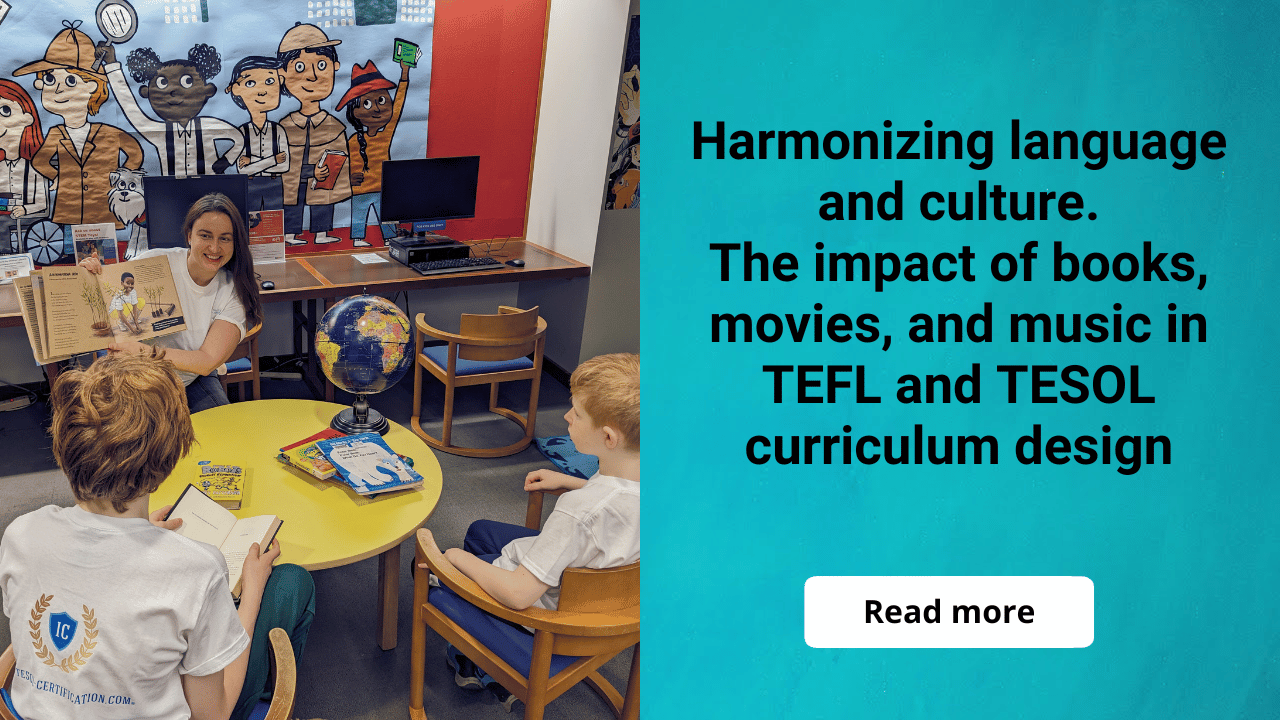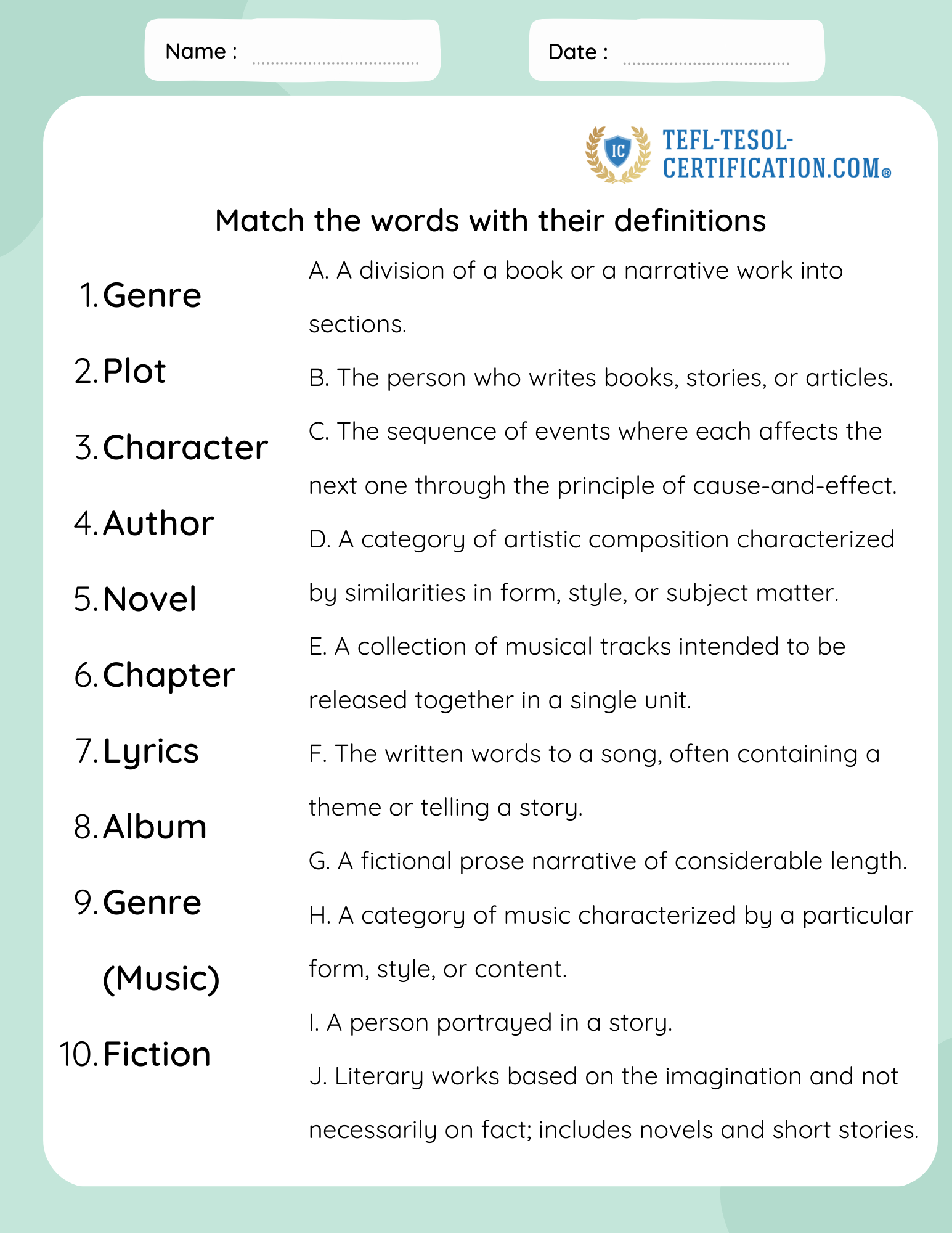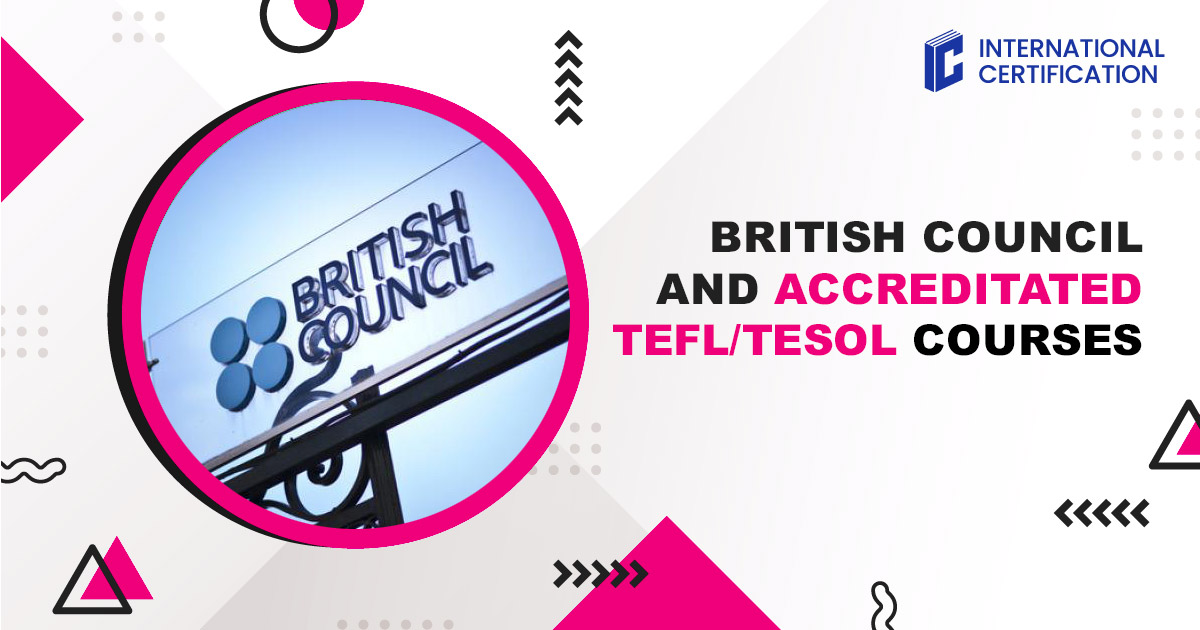And start earning money 💸 by teaching English in your own country, abroad, or online from anywhere on the planet! 🎁 Gifts and bonuses: professional support from your personal coach 🧑🏫 and job placement assistant 💼.

Harmonizing language and culture. The impact of books, movies, and music in TEFL and TESOL curriculum design
Table of contents
Introducing English learners to the topic of movies, books, and music is not merely about expanding vocabulary or enhancing listening skills; it's about opening doors to diverse cultures, fostering creative thought, and building bridges of communication. These mediums are universal forms of expression, transcending geographical and linguistic barriers, and they offer a rich tapestry of narratives, emotions, and perspectives. For students of English, delving into these areas provides a contextually rich environment for language acquisition, encouraging them to engage with authentic language use, understand nuance, and express complex ideas and feelings. Moreover, movies, books, and music are reflections of societal values, historical events, and human experiences, making them invaluable tools for cultural immersion and fostering empathy and global awareness. As such, integrating these topics into the English language curriculum is not just beneficial but essential for a holistic and engaging learning experience.
Always keep in mind the big goal you set within the timeframe of the course, and do not forget to set an achievable objective your students will reach within a lesson. If you decide to merge the topics of books, movies, and music into one lesson or into a set of lessons, then the objective may sound like this:
By the end of the lesson, students will be able to discuss and express opinions about movies, books, and music in English, using B1-level vocabulary and grammar.
Discussing films in English
To warm-up your students start the lesson with the discussion.
- Ask students about their favorite movie, book, or piece of music.
- Write their answers on the board.
- Ask follow-up questions to encourage full sentences, e.g., "Why do you like it?", "Who is your favorite character/author/musician?"
The next activity from which your students might benefit is the introduction of vocabulary and a matching exercise.

What your students will definitely like is to watch a trailer of the popular movie in the class. So you can make the next Listening Exercise:
- Play a popular movie trailer.
For example, "The Lord of the Rings: The Fellowship of the Ring"
- Hand out a set of comprehension questions about the trailer.
Instructions for Students:
Watch the trailer for "The Lord of the Rings: The Fellowship of the Ring" on YouTube. After watching, answer the following questions:
Comprehension Questions:
- Setting and Atmosphere: Describe the setting of the movie. What kind of atmosphere is created in the trailer?
- Characters: Name at least three characters shown in the trailer. Describe one character based on what you saw. What do they look like? What do you think their personality is like?
- Plot: What event or problem seems to be the central focus of the movie based on the trailer?
- Dialogue or Narration: Quote one line of dialogue or narration from the trailer that you found interesting or important. Why do you think this line is significant?
- Visuals and Effects: What kind of special effects are used in the trailer? How do these effects contribute to the overall feeling of the movie?
- Music and Sound: Describe the music and sound in the trailer. How does it enhance the mood or the action?
- Your Opinion: Based on the trailer, would you like to watch the full movie? Why or why not?
- Play the trailer a second time if needed.
- Discuss the answers as a class.
Discussing books in an English lesson
When discussing books with your students, it's essential to incorporate a reading exercise, as it directly enhances their comprehension and engagement with the material.
- Distribute a handout with a short excerpt from a popular book at the B1 level.
For example, excerpt from "Charlie and the Chocolate Factory" by Roald Dahl, a book suitable for B1 level students:Mr. Willy Wonka can make marshmallows that taste of violets, and rich caramels that change color every ten seconds as you suck them, and little feathery sweets that melt away deliciously the moment you put them between your lips. He can make chewing-gum that never loses its taste, and sugar balloons that you can blow up to enormous sizes before you pop them with a pin and gobble them up. And, by a most secret method, he can make lovely blue birds' eggs with black spots on them, and when you put one of these in your mouth, it gradually gets smaller and smaller until suddenly there is nothing left except a tiny little PINK sugary baby bird sitting on the tip of your tongue.
Mr. Willy Wonka was standing all alone just inside the open gates of the factory. And what an extraordinary little man he was! He had a black top hat on his head. He wore a tail coat made of a beautiful plum-colored velvet. His trousers were bottle green. His gloves were pearly gray. And in one hand he carried a fine gold-topped walking cane. Covering his chin, there was a small, neat, pointed black beard—a goatee. And his eyes—his eyes were most marvelously bright. They seemed to be sparkling and twinkling at you all the time. The whole face, in fact, was alight with fun and laughter.Have students read the excerpt silently.
- Ask comprehension questions about the excerpt.
Comprehension Questions:
- Descriptive Language: Describe Mr. Willy Wonka's appearance based on the excerpt.
- Imagery: What are some of the unique sweets mentioned by the narrator, and what makes them special?
- Character Traits: How does the author portray Mr. Willy Wonka's personality through his description?
- Sensory Details: Choose one of the sweets described in the passage. How do you imagine it would taste, look, and feel?
- Predictions: What are your first impressions of Mr. Willy Wonka? What kind of person do you think he is, and why?
- Inference: Based on the description of Mr. Willy Wonka and his creations, what can you infer about the theme or atmosphere of the factory?
- Discuss new vocabulary words found in the text.
Discussing music preferences
Having explored the realms of movies and books, it's now time to dive into the world of music. This presents an excellent opportunity to engage in group or pair discussions, providing students ample time to practice and enhance their speaking skills through dynamic conversations.
Instructions:
- Divide students into small groups or pairs.
- Each group/pair discusses their favorite type of music, their favorite song, and why they like it.
- Encourage students to use the vocabulary introduced earlier in the lesson.
- Ask a few groups to share their discussion with the class.
Naturally, you'll be monitoring the activity, carefully observing and taking notes on each student's performance to provide targeted feedback and support their learning journey.
💡 Unlock the secrets to doubling your teaching income with our exclusive checklist! 🎯 This checklist is designed for English teachers who want to 📈 attract more students and 🔥 keep them engaged for the long term.
Wrap-up and Homework
Instructions:
- Quickly review the vocabulary and main points from the lesson.
- For homework, assign each student to write a short paragraph about their favorite movie, book, or piece of music using the vocabulary from the lesson.
- Remind students to bring their paragraphs to the next class for a peer review activity.
Conclusion
Get your TEFL TESOL certification
Travel, work online, get a job abroad, or be
an EFL and ESL teacher in your country.
In conclusion, the creation of well-structured lesson plans that are in harmony with clearly defined objectives is fundamental to the success of any English language course. Such meticulous planning ensures that each lesson contributes effectively towards achieving the overarching educational goals, fostering a cohesive and progressive learning experience for students. It is imperative for English teachers to hold TEFL (Teaching English as a Foreign Language) and TESOL (Teaching English to Speakers of Other Languages) certifications, as these qualifications equip educators with the essential pedagogical skills and methodologies required to navigate the diverse and complex landscape of language teaching. Moreover, incorporating topics such as books, movies, and music into the curriculum is of paramount importance. These subjects not only enrich the learning environment by providing a multifaceted approach to language acquisition but also serve as vital tools for cultural immersion, enhancing students' understanding and appreciation of the English language in its most vibrant and authentic forms. Therefore, a teacher's commitment to continuous professional development, coupled with a well-rounded and thoughtfully designed curriculum, is key to nurturing Procient, confident, and culturally aware English language speakers.
Terms used:
EFL, ESL, TEFL, TESOL

York Fern
An English instructor with 12+ years of experience. I work for an online school and travel the world, teaching students from various countries, leveraging my TEFL/TESOL certification. Seeing the world's oceans, mountains, and cities with my own eyes has given me a profound appreciation for the importance of quality education and international communication.
and start earning by teaching English in your country, abroad, or online from anywhere in the world! Order the course with a 50% discount 💸 and receive as a gift the support of a personal coach 👨🏫 and job placement assistant! 🎁🚀 Hurry, limited spots available! 🏃♂️💨
💡 Unlock the secrets to doubling your teaching income with our exclusive checklist! 🎯 This checklist is designed for English teachers who want to 📈 attract more students and 🔥 keep them engaged for the long term.
🚀 More students, 💰 higher income, 🌍 complete freedom! ✅ 112 verified platforms with top rates ⏳ Flexible schedule – work whenever and as much as you want 🎯 Simple requirements – start earning right away 💎 Boost your career and income by teaching students worldwide!
choose us?



